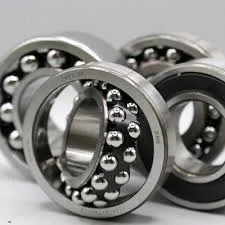
Dec . 10, 2024 21:31 Back to list
Specifications and Features of 6319 and Similar Bearing Types for Industrial Applications
Understanding the 6319 Bearing Specifications
The 6319 bearing is a crucial component often used in various mechanical systems, including electric motors, industrial machinery, and agricultural equipment. This article delves into the specifications, features, and applications of the 6319 bearing, providing a comprehensive understanding for engineers, designers, and manufacturers.
Design and Construction
The 6319 bearing is classified as a deep groove ball bearing. Its design typically includes an outer ring, an inner ring, a cage, and a set of balls. This configuration allows for low friction during operation and enables the bearing to support both radial and axial loads. The basic dimensions of the 6319 bearing are
- Inner Diameter (d) 95 mm - Outer Diameter (D) 200 mm - Width (B) 45 mm
These dimensions make the 6319 bearing suitable for medium to heavy load applications while maintaining a compact size.
Material Composition
Bearings are usually made from high-carbon chromium steel, which provides excellent hardness and wear resistance. The 6319 bearing often utilizes this material, ensuring a long service life even under high-load conditions. Some variants may also be manufactured using stainless steel or ceramic materials, particularly in applications that require corrosion resistance or operate in extreme conditions.
Load Ratings
One of the essential specifications for bearings is the load rating, which indicates the maximum load that a bearing can sustain while operating efficiently. The dynamic load rating for the 6319 bearing is approximately 50,500 N, and the static load rating is about 57,800 N. Understanding these ratings is critical for selecting the right bearing for specific applications, as exceeding the load limits can lead to premature failure.
Speed Ratings
The 6319 bearing is designed to handle a maximum speed of around 3,600 revolutions per minute (RPM) under typical load conditions. However, the speed rating can vary depending on factors such as lubrication, load, and operating temperature. It is essential to consider these parameters when choosing the bearing for high-speed applications to prevent overheating and potential damage.
6319 bearing specifications

Lubrication Options
Proper lubrication is vital for the optimal functioning and longevity of the 6319 bearing. Lubricants reduce friction between moving parts and help dissipate heat. Common lubrication options include grease and oil, with each offering its advantages. Grease is often preferred for its ability to stay in place and reduce leakage, while oil can provide better cooling properties.
Applications
The versatility of the 6319 bearing allows it to be used in a wide variety of applications. Common uses include
1. Electric Motors The 6319 bearing is frequently employed in the rotors and stators of electric motors due to its capability to handle variable loads and speeds. 2. Pumps In various types of pumps, the bearing ensures smooth operation, contributing to the overall efficiency and reliability of the equipment.
3. Industrial Machinery The 6319 bearing is integral in numerous industrial machines, from conveyors to manufacturing equipment, providing stability and support.
4. Agricultural Equipment In farming machinery, these bearings help in the movement of components, ensuring durability and resilience in harsh environments.
Installation and Maintenance
Correct installation of the 6319 bearing is vital to its performance. Proper alignment, adequate lubrication, and ensuring that tolerances are met can significantly impact the bearing's lifespan. Regular maintenance, such as monitoring lubrication levels and checking for wear, is also crucial to prevent unexpected failures.
Conclusion
The 6319 bearing plays a significant role in many industrial applications due to its robust design, load-bearing capabilities, and versatility. With a thorough understanding of its specifications and features, engineers and manufacturers can make informed decisions when selecting the appropriate bearing for their needs. By considering factors like load ratings, speed capabilities, and lubrication, they can ensure optimal performance and durability in their mechanical systems.
Latest news
-
Premium Deep Groove Ball Bearings | High Speed & Reliability
NewsAug.29,2025
-
Durable Scaffolding Clamps - Secure & Reliable Tube Connectors
NewsAug.28,2025
-
Common Failures in Thrust Ball Bearings and Solutions
NewsAug.22,2025
-
How Tapered Roller Bearings Can Take Shock Loads
NewsAug.22,2025
-
Angular Bearings in High-Precision Spindles
NewsAug.22,2025
-
The Impact of Misalignment on Cylindrical Roller Bearing Performance
NewsAug.22,2025
